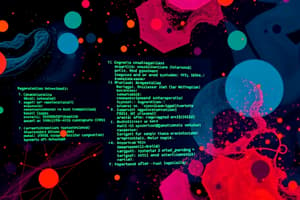Podcast
Questions and Answers
What is a hybrid operating system?
What is a hybrid operating system?
- An operating system that does not load modules dynamically
- An operating system that is purely monolithic
- An operating system that is purely microkernel
- An operating system that combines multiple approaches (correct)
What are the key components of Apple Mac OS X?
What are the key components of Apple Mac OS X?
Mach microkernel and BSD Unix parts, plus I/O kit and kernel extensions
Linux and Solaris use a purely monolithic kernel.
Linux and Solaris use a purely monolithic kernel.
False (B)
What replaces the BIOS in modern systems?
What replaces the BIOS in modern systems?
What is the function of a bootstrap loader?
What is the function of a bootstrap loader?
Which of the following is a common bootstrap loader?
Which of the following is a common bootstrap loader?
Which of the following is a user interface provided by operating systems?
Which of the following is a user interface provided by operating systems?
What is the primary function of program execution in an operating system?
What is the primary function of program execution in an operating system?
Error detection in an operating system only needs to be aware of errors in user programs.
Error detection in an operating system only needs to be aware of errors in user programs.
Which of the following are types of resource sharing in operating systems?
Which of the following are types of resource sharing in operating systems?
What are system calls?
What are system calls?
The __________ provides the necessary infrastructure to load and execute programs.
The __________ provides the necessary infrastructure to load and execute programs.
Modern operating systems typically link libraries into executables.
Modern operating systems typically link libraries into executables.
What is the main advantage of a microkernel architecture?
What is the main advantage of a microkernel architecture?
Match the following components of system services:
Match the following components of system services:
What is the purpose of system programs?
What is the purpose of system programs?
Flashcards are hidden until you start studying
Study Notes
Operating System Services Overview
- Operating systems (OS) create an environment for program execution and provide essential services for users and programs.
- Services include user interfaces, program execution, I/O operations, file system manipulation, communication, error detection, resource allocation, protection, and security.
User Interface Types
- User interfaces (UIs) vary significantly among OS:
- Command-Line Interface (CLI) - direct command entry.
- Graphical User Interface (GUI) - user-friendly, utilizes desktops, icons, and mouse interactions.
- Touchscreen Interfaces - rely on gestures and virtual keyboards for user input.
Program Execution and I/O Operations
- OS must load programs into memory, execute them, and handle normal or abnormal terminations.
- I/O operations can involve files and devices, allowing programs to interact with external components.
File System Functions
- Essential functions include reading, writing, creating, deleting files/directories, and managing permissions.
- File systems facilitate organized data storage and retrieval.
Communication Services
- Allow processes to exchange information, whether within the same computer or over a network.
- Methods include shared memory or message passing.
Error Detection and Debugging
- Continuous monitoring of hardware and software is required to identify errors.
- The OS must take corrective actions based on the type of error detected.
- Debugging facilities enhance the efficiency of user and programmer interaction with the system.
Resource Management
- Resource allocation is crucial when multiple users or processes operate simultaneously.
- Types of resources managed include CPU cycles, memory, storage, and I/O devices.
- Logging tracks resource usage to maintain system performance.
Protection and Security
- Access control is vital in multiuser and networked environments to protect sensitive information.
- User authentication safeguards the system against unauthorized access.
System Calls and Interfaces
- System calls provide a programming interface for OS services, typically accessed via high-level APIs.
- Common APIs include Win32 for Windows, POSIX for UNIX/Linux, and Java API for JVM.
System Call Implementation
- Each system call is associated with a unique number for the interface to invoke the desired functionality.
- The API abstracts the implementation details from the programmer.
Parameter Passing Methods
- Parameters for system calls can be passed using:
- Registers.
- Memory blocks identified by address.
- Stacks, allowing flexible handling of multiple parameters.
System Program Services
- Offer a user-friendly environment for program development and execution.
- Functions include:
- File manipulation and status information.
- Programming language support.
- Program loading and execution management.
- Inter-process communications.
Background Services and Daemons
- Background services operate during boot time for system tasks such as scheduling and logging.
- They run in user context rather than kernel context and are known as daemons.
Linkers and Loaders
- Linkers create binary executables from relocatable object files, integrating required libraries.
- Loaders bring programs from secondary storage into memory for execution.
Operating System Structures
- Varied structural models for OS:
- Simple Structure (e.g., MS-DOS)
- Complex Structure (e.g., UNIX)
- Layered Architecture - modular layers providing abstraction.
- Microkernel - minimal core with extensions for additional functionalities.
Hybrid Operating Systems
- Modern OS often combine multiple models for enhanced performance and security.
- Examples include:
- Linux and Solaris - monolithic with modular features.
- Windows - primarily monolithic, incorporating microkernel tasks.
- Apple macOS - hybrid structure with layers and loadable modules.
System Boot Process
- The system boot process starts at a fixed memory location upon power-up.
- The bootstrap loader or BIOS loads the OS kernel into memory.
- Modern systems may utilize UEFI, and boot loaders like GRUB manage kernel selection and multi-boot options.
Studying That Suits You
Use AI to generate personalized quizzes and flashcards to suit your learning preferences.



